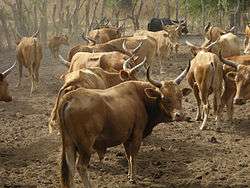N'Dama

N'Dama is a breed of cattle from West Africa. Other names for them include Boenca or Boyenca (Guinea-Bissau), Fouta Jallon, Fouta Longhorn, Fouta Malinke, Futa, Malinke, Mandingo (Liberia), and N'Dama Petite (Senegal). Originating in the Guinea highlands, they are also found in southern Senegal, Guinea-Bissau, the Gambia, Mali, Ivory Coast, Liberia, Nigeria, and Sierra Leone. They are trypanotolerant, allowing them to be kept in tsetse fly-infested areas.[1][2] They also show superior resistance to ticks and the diseases they carry and to Haemonchus contortus stomach worms.[3]
In the 19th century, N'Dama were imported to the Caribbean Island of Saint Croix from Senegal, and later crossed with Red Polls to form the Senepol breed.[4]
Reproduction
The age of first calving is 3.5 years in Upper Casamance and is slightly lower in Lower and Middle Casamance. The calving interval is 16 to 17 months in Middle and Upper Casamance and roughly 19 months in Lower Casamance with 80% of calving taking place in the last six months of the year. The abortion rate is 10 to 20%, which leaves an average calving rate of 56%. Calves are weaned around 12 months and castration, when it occurs, is around three years. Annual mortality rate is 12% overall, with 30% for calves under one year, 15% for one to two-year-olds, 5% for two to three-year-olds, and 2% for adults. [5]
References
- ↑ Charles G. Hickman, Cattle Genetic Resources Elsevier Health Sciences, 1991 ISBN 0-444-88638-9 p34
- ↑ Oklahoma State University breed profile
- ↑ FAO study; The state of agricultural biodiversity in the livestock sector p99
- ↑ Oklahoma State University
- ↑ Trypanotolerant livestock in West & Central Africa - Volume 2. Country studies
| Wikimedia Commons has media related to N'Dama. |